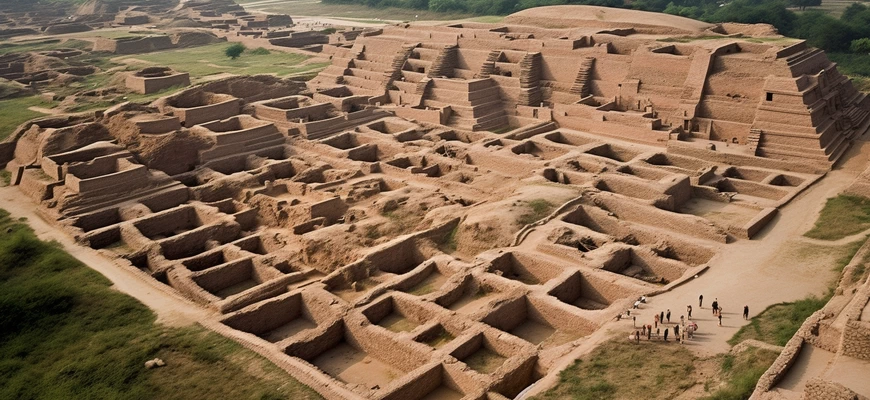The Harappan civilization, which flourished in northwestern India around 2600-1900 BC, was one of the largest and most advanced ancient civilizations. It left significant marks on human history, particularly in the fields of architecture, art, and writing. This civilization is known for its innovations in agriculture, such as the use of irrigation and the use of large animals to work the fields. Although many aspects of this civilization remain a mystery, it remains highly influential in human history.
- History and origins of the Harappan civilization
- Culture and society of the Harappan civilization
- Religion and mythology
- Excavations and finds
- Economy and economy of the Harappan civilization
- Trade and crafts
- The fall of the Harappan civilization and its legacy
- Reasons for the decline
- Influence on other cultures and our world today
- Conclusion
History and origins of the Harappan civilization
The Harappan civilization flourished in the Indus Valley in northwestern India and Pakistan around 2600-1900 BC. The history and origins of this civilization are a matter of debate among researchers. However, most scholars believe that it was created by the indigenous peoples living in the region, and was not brought from abroad.
The first Harappan settlements appeared near the Indus River in 3300 BC. Over time, these settlements began to develop, forming one of the largest and most advanced ancient civilizations in the world. The Harappan civilization takes its name from the Harappan archaeological site, where one of the largest archaeological sites of this civilization was discovered. The history and origin of the Harappan civilization are complex and multifaceted issues that require detailed research and analysis.
Culture and society of the Harappan civilization
The Harappan civilization had a developed culture and society, which was reflected in architecture, art, religion, and other aspects of life. The architecture was highly developed and included cities with an extensive network of streets, neighborhoods, irrigation systems, and large public facilities such as large swimming pools.
The Harappan artistic tradition is known for the clay figurines that have been found depicting people, animals, and other objects. This culture also had religious practices that were depicted on reliefs and ritual tools.
The society of the Harappan civilization was organized according to a class system. It consisted of several social groups, including rulers, priests, artisans, and peasants. This civilization also had developed trade with other regions, which indicates a high level of economic development. In general, the culture and society of the Harappan civilization were quite advanced and complex for their time.
Religion and mythology
The religious beliefs and mythology of the Harappan civilization remain a mystery to scientists. But a lot of knowledge can be gained from ritual tools, reliefs, and images on seals. According to these sources, it seems that they believed in a large, multi-headed deity. They also believed in other deities, such as a mother goddess, an animal god, and a god of death.
Mythological depictions of animals such as the bull, tiger, elephant, crocodile, and others were also popular. These images seemed to have a ritualistic or symbolic meaning. Other images, such as those depicting ritual scenes, may indicate that the Harappan civilization had a developed religious system with a high level of organization and rituals.
Art and architecture
The art and architecture of the Harappan civilization is striking in its uniqueness and complexity. They include a variety of art forms such as clay sculpture, seals, drawings on ceramics and building walls.
Harappan architecture is known for its majestic megalithic buildings, such as multi-story houses, water storage tanks, temples, and plazas. One of the most impressive buildings is the Kala Dharo, a large city with a complex system of canals and reservoirs.
Images on seals and other artistic products of the Harappan civilization may indicate an understanding of the harmony of nature and a desire to connect humans with the cosmos. They may also reflect their religious and mythological beliefs. In general, the art and architecture of the Harappan civilization show a high level of development of this ancient civilization.
Excavations and finds
Excavations of the Harappan civilization began in the 1920s. The largest archaeological finds were made on the territory of modern India and Pakistan, where most of the archaeological sites of this civilization are located.
Among the most important finds is the city of Moenjodaro, which was discovered in 1922. Many buildings, tanks, and several thousand artifacts, such as clay figurines, seals, ceramics, and others, were found here.
Another important find is Harappa, which was discovered in 1921. Massive megalithic buildings such as multi-story buildings, temples, and squares were found here.
Systems of canals and water storage tanks were also found, indicating a high level of hydraulic engineering development. The findings indicate that the Harappan civilization was a highly developed and rather complex civilization that had a great influence on the development of the ancient world.
Economy and economy of the Harappan civilization
The Harappan civilization was known for its highly developed economy and economy. It was engaged in agriculture, animal husbandry, and crafts. The importance of agriculture is confirmed by the fact that many irrigation systems were discovered on the territory of the civilization, which allowed to grow crops and provide the population with food.
The Harappans also produced and traded silk, cotton, linen, and other materials. They were known for their high quality ceramics and metallurgy, including the production of copper and bronze products.
Trade took place through river routes that connected the Harappan civilization with other civilizations such as Mesopotamia and Elam. Excavations have revealed the remains of trading posts and warehouses.
The Harappans also used money, which was made of gold, silver, and copper. Money was used for trade and for various transactions.
Agriculture and animal husbandry
Agriculture and animal husbandry were important components of the Harappan economy. Harappans were engaged in agriculture and grew wheat, barley, peas, soybeans, cotton, and other crops. They used irrigation systems to provide water for their fields and practiced multiple tillage.
The Harappans were also involved in animal husbandry, raising sheep, goats, cows, buffaloes, and water buffaloes. They used the milk, meat, and skins of these animals.
The Harappans also produced honey using their own bees and apiaries. Their ability to grow and harvest various crops, as well as to make textiles and handicrafts, helped them develop trade with other civilizations.
Trade and crafts
Trade and craft were important aspects of Harappan civilization. The Harappans were known for their handicrafts, particularly bronze, gold, and silverware. They also made textiles such as shawls, sarongs, and other cotton products.
The Harappans traded with other civilizations, especially those in western India. They exchanged metal products, textiles, and other valuables. The Harappan civilization also had its own merchant flotilla, which allowed them to trade with other countries on the shores of the Persian Gulf and in western India.
Such trade contributed to the development of the Harappan economy and culture, and also facilitated the spread of knowledge and ideas between different civilizations.
The fall of the Harappan civilization and its legacy
To this day, there is no accurate information about the causes of the fall of the Harappan civilization. However, some studies point to possible reasons, such as climate change, environmental disasters, epidemics, and invasions by other nations.
Despite the fall of the civilization, its legacy was important for the further development of Indian history. Many of the achievements of the Harappan civilization were inherited by subsequent civilizations, such as the Vedic civilization and others. In addition, the excavations and discoveries associated with the Harappan civilization contributed to the further study of Indian history and culture.
Reasons for the decline
To this day, there are several theories about the reasons for the decline of the Harappan civilization. One of the most accepted theories suggests that climate change, particularly droughts and floods, may have led to the destruction of fertile soil and reduced crops. Other possible causes include environmental disasters, epidemics, invasions by other nations, social change, and political instability.
According to archaeological research, the decline of the Harappan civilization occurred gradually, not suddenly. For example, the decrease in the size of buildings and the number of finds from the Zinc and Bronze Ages indicate a deteriorating economic situation and a decline in living standards. However, the reasons for the decline of the Harappan civilization remain a subject of debate among historians and archaeologists.
Influence on other cultures and our world today
The Harappan civilization influenced the development of many other cultures, including Hinduism and Buddhism. This civilization is known for its writing system, which was important for the further development of other cultures in the region. In addition, the Harappan civilization left behind important archaeological finds that help us study the life and culture of the time.
Today, the Harappan civilization leaves a mark on our world through the use of some of its achievements, such as the urban planning and sewage system, which can be applied in modern construction. In addition, studying the Harappan civilization can help us understand how ancient civilizations developed and functioned, as well as explore interesting aspects of their culture and society.
Conclusion
The Harappan civilization is one of the most mysterious and intriguing ancient civilizations. Its history and culture are still a subject of research and discussion among scholars and historians. This civilization had its own unique way of life, which included a developed system of agriculture, crafts, trade, and religion. Although the reasons for its fall are still not fully understood, archaeological finds and research allow us to reconstruct the life and culture of this ancient civilization. Its influence on other cultures and our world today is extremely important and interesting. The Harappan civilization remains a landmark in human history that is still an object of study and wonder.








